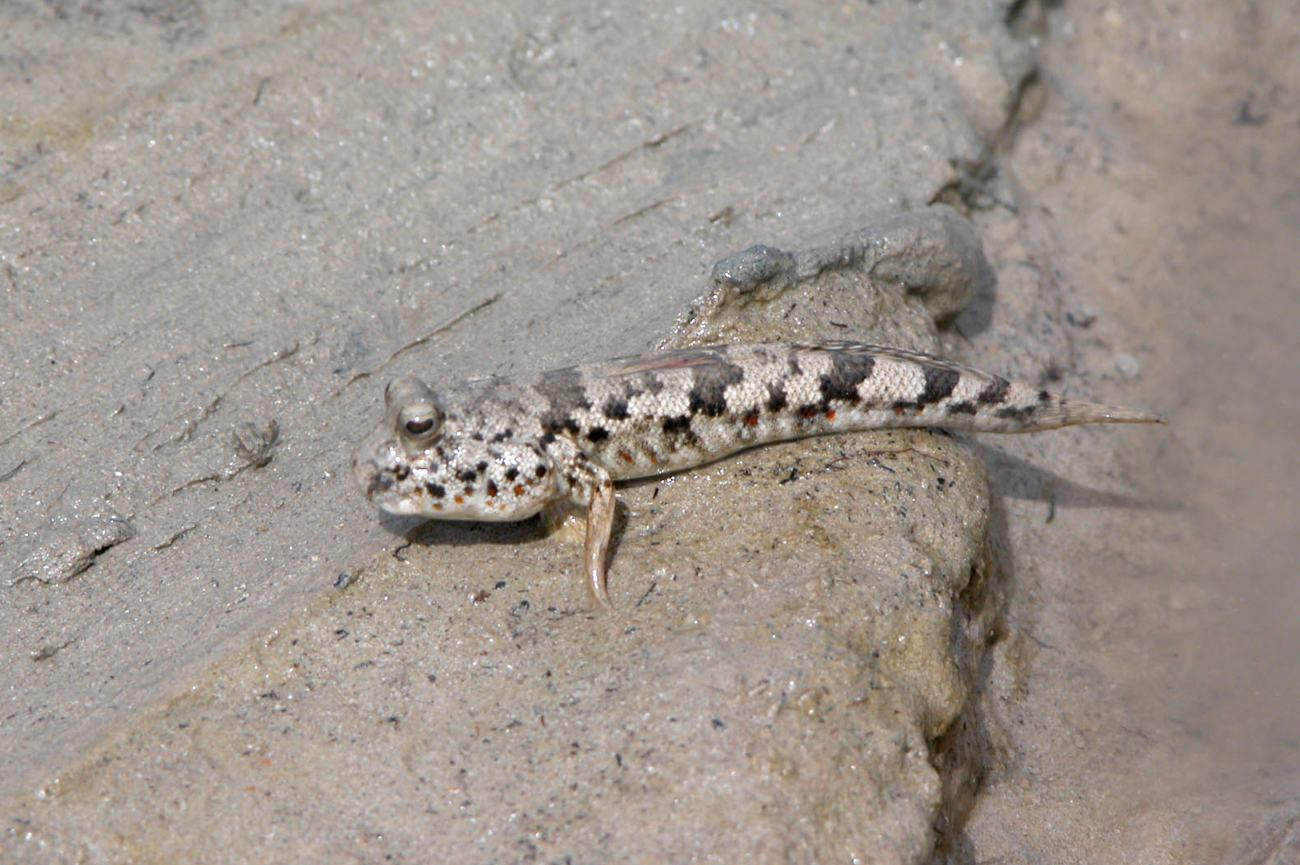Takita's Mudskipper, Periophthalmus takita Jafaar & Larson 2008

A Takita Mudskipper, Periophthalmus takita, at Ludmilla Creek, Darwin, Northern Territory. Source: Toru Takita / FishBase. License: All rights reserved
A mottled pale grey to greyish-brown mudskipper becoming paler below, with conspicuous orange, reddish-brown and dark brown spots (and smaller white spots) on the head and sides, a large reddish-brown to dark brown first dorsal fin with pale spines and a rounded margin, the second dorsal fin with two broad blackish stripes on a white background and dark spots near the base of the fin, and an orange anal fin.
Takita's Mudskipper, Periophthalmus takita Jafaar & Larson 2008
More Info
|
Distribution |
Northern Australia from Port Hedland, Western Australia, to Tin Can Bay, Queensland. The species also occurs in the Fly River, Papua New Guinea. Inhabits mudflats and mangroves in coastal estuaries, usually just in front of the pneumatophore (aerial root) zone. |
|
Features |
Dorsal fin VII-XI (usually VIII) + I, 11-12; Anal fin I, 10-12; Pectoral fin 13-15; Caudal fin 16-18; Lateral scales 58-73; Predorsal scales 22-31. Body relatively robust, compressed; head somewhat cylindrical; pelvic fin frenum prominent with sparse small brown spots on dorsal surface; innermost pelvic-fin rays only fused for half to three-quarters of their length; first dorsal fin broadly rounded. |
|
Colour |
Overall pale grey, whitish below; cheeks, pectoral-fin base and anterior part of body with small, rounded, blackish spots; lower half of head and body with numerous distinct round orange spots (less numerous posteriorly); first dorsal fin greyish to black, with a very thin, white margin along spine tips; second dorsal fin whitish-grey with two broad black bands, one sub-marginal and one medial, a narrow pale marginal stripe, and a basal row of black spots; anal fin creamish to pale orange; pectoral fins pale with fine dusky markings mostly along fin rays; caudal fin dusky to pinkish-grey; dorsal surface of pelvic-fin frenum with sparse, small brown spots. |
|
Etymology |
The species is named for Dr. Toru Takita, in recognition of his contributions to the knowledge of the ecology of mudskippers. |
|
Species Citation |
Periophthalmus takita Jaafar & Larson, 2008, Zool. Sci. 25(9): 946, figs 1-5. Type locality: Camerons Beach, Northern Territory, Australia. |
|
Author |
Bray, D.J. 2025 |
|
Resources |
Takita's Mudskipper, Periophthalmus takita Jafaar & Larson 2008
References
Allen, G.R., Midgley, S.H. & Allen, M. 2002. Field Guide to the Freshwater Fishes of Australia. Perth : Western Australian Museum 394 pp. (in part as Periophthalmus novaeguineaensis)
Jaafar, Z. & Larson, H.K. 2008. A new species of mudskipper, Periophthalmus takita (Teleostei: Gobiidae: Oxudercinae), from Australia, with a key to the genus. Zoological Science (Tokyo) 25: 946–952
Larson, H.K. & Takita, T. 2004. Two new species of Periophthalmus (Teleostei: Gobiidae, Oxudercinae) from northern Australia, and a re-diagnosis of Periophthalmus novaeguineaensis. The Beagle, Records of the Museums and Art Galleries of the Northern Territory 20: 175-185 (in part as Periophthalmus novaeguineaensis)
Larson, H.K., Williams, R.S. & Hammer, M.P. 2013. An annotated checklist of the fishes of the Northern Territory, Australia. Zootaxa 3696(1): 1-293
Murdy, E.O. 1989. A taxonomic revision and cladistic analysis of the oxudercine gobies (Gobiidae: Oxudercinae). Records of the Australian Museum, Supplement 11: 1-93 figs 1-98 pls 1-3 (in part as Periophthalmus novaeguineaensis)
Murdy, E.O. & Jaafar, Z. 2017. Chapter 1: Taxonomy and Systematics Review. pp. 1-36 in Jaafar, Z. & Murdy, E.O. (eds). Fishes Out of Water: Biology and Ecology of Mudskippers. Boca Rotan, Florida : CRC Press 390 pp.
Parenti, L.R. & Jaafar, Z. 2017. Chapter 2: The Natural Distribution of Mudskippers. pp. 37-68 in Jaafar, Z. & Murdy, E.O. (eds). Fishes Out of Water: Biology and Ecology of Mudskippers. Boca Rotan, Florida : CRC Press 390 pp.
Polgar, G., Sacchetti, A. & Galli, P. 2010. Differentiation and adaptive radiation of amphibious gobies (Gobiidae: Oxudercinae) in semi-terrestrial habitats. Journal of Fish Biology 77(7): 1645–1664
Takita, T., Larson, H.K. &.Ishimatsu, A. 2011. The natural history of mudskippers in northern Australia, with field identification characters. The Beagle, Records of the Museums and Art Galleries of the Northern Territory 27: 189-204



